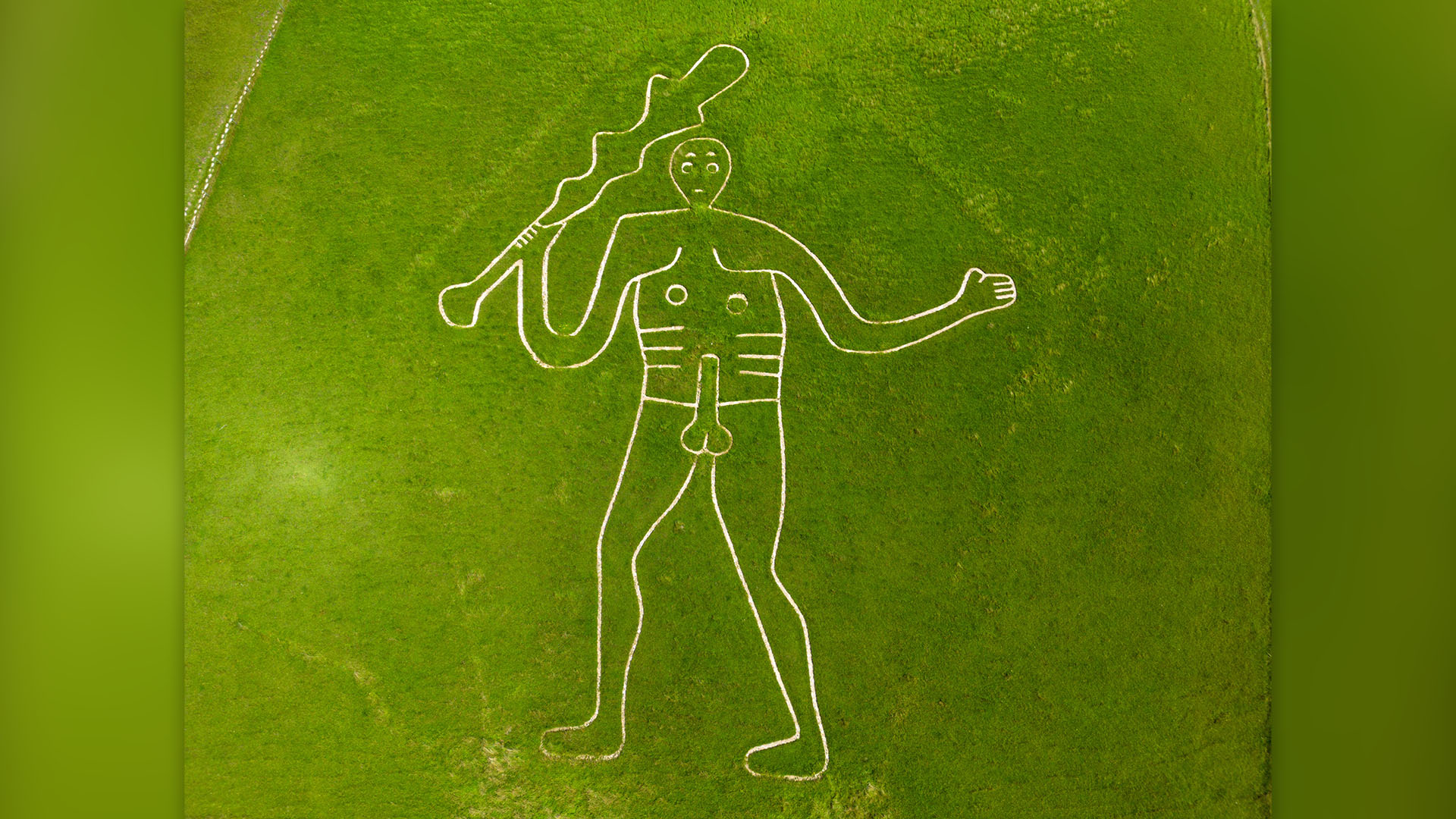180-foot early medieval carving of naked bald man with club is probably Hercules, new study suggests
The huge chalk carving in the English countryside was likely a meeting place for local forces rallying against the Vikings.

A giant, enigmatic carving of a naked, bald man wielding a hefty club likely depicts the mythical Hercules, a new study finds.
The early medieval artwork, carved into the chalk bedrock on a hillside above the village of Cerne Abbas in Dorset, England, was likely created to mark a meeting point for West Saxon armies that were readying to fight the invading Vikings, according to the study, published in the January issue of the journal Speculum. Later, monks in Cerne Abbas — who likely didn't want a pagan figure in their midst — reinterpreted the huge carving to be the local saint, Eadwold, the team said.
"The monks of Cerne wouldn't have portrayed their patron saint as naked if they were carving him from scratch, but they were happy to co-opt him as an image of Eadwold for their own purposes," study co-author Tom Morcom, a postdoctoral researcher in the Department of Philosophy, Classics, History of Art and Ideas at the University of Oslo in Norway, said in a statement.
Related: Statue of slain Roman emperor dressed as Hercules found near sewer in Rome
Archaeologists have known about the Cerne Abbas giant for centuries, but many thought it dated to prehistoric times. That changed in 2021, when research revealed that the giant was much younger, dating to between A.D. 700 and 1110. This time window, based on optically stimulated luminescence (OSL) dating — a technique that calculates the last time crystalline materials in the artwork, such as minerals, were exposed to sunlight or heat — showed that the giant's emergence in the Anglo-Saxon period coincided with the Viking Age (793 to 1066).
The giant is an impressive site to behold, standing 180 feet (55 meters) tall with a club clenched in his right hand. His left hand is outstretched, and it's likely that it originally held Hercules' iconic lion skin, which he obtained from slaying the beast as part of his 12 labors, the researchers said. Medieval artists also included the bald man's nipples, ribs, belt and phallus.
During the Middle Ages, the myth of Hercules was well known and experienced a spike in interest during the ninth century, the researchers said. The prominent knotted club is one clue that the carving depicts the hero, as this weapon "acted as an identificatory label, like the keys of Saint Peter or the wheel of Saint Catherine," the researchers wrote in the study.
Sign up for the Live Science daily newsletter now
Get the world’s most fascinating discoveries delivered straight to your inbox.
They added that the carving is just 16 miles (26 kilometers) south of Portland, the site of the first recorded encounter between an Anglo-Saxon and Viking raiders, which occurred a few years before the 793 Viking attack on Lindisfarne. There are other early medieval chalk carvings in the region, and this one might have served as a rallying point for local forces gathering to fight the Vikings, as the spot was close to fresh water and supplies from local estates, the researchers said.
"It's become clear that the Cerne Giant is just the most visible of a whole cluster of early medieval features in the landscape," study co-author Helen Gittos, an associate professor of early medieval history at the University of Oxford, said in the statement.
In the 11th century, local monks gave Hercules a makeover, rebranding him as Eadwold of Cerne, a ninth-century hermit said to be the king's brother and a miracle worker.
"The Giant has long been loved and looked after, and such reidentifications continue into the present day," Morcom said.

Laura is the archaeology and Life's Little Mysteries editor at Live Science. She also reports on general science, including paleontology. Her work has appeared in The New York Times, Scholastic, Popular Science and Spectrum, a site on autism research. She has won multiple awards from the Society of Professional Journalists and the Washington Newspaper Publishers Association for her reporting at a weekly newspaper near Seattle. Laura holds a bachelor's degree in English literature and psychology from Washington University in St. Louis and a master's degree in science writing from NYU.









